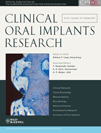Location of posterior superior alveolar artery and evaluation of maxillary sinus anatomy with computerized tomography: a clinical study
Abstract
Objectives: Knowledge and evaluation of the maxillary sinus anatomy before sinus augmentation are essential for avoiding surgical complications. Posterior superior alveolar artery (PSAA) is the branch of maxillary artery that supplies lateral sinus wall and overlying membrane. The aims of this study were to examine the prevalence, diameter, and location of the PSAA and its relationship to the alveolar ridge and to study the prevalence of the sinus pathology and septum using computerized tomography (CT) scans.
Materials and methods: One hundred and twenty-one CT scans (242 sinuses) from patients undergoing sinus augmentation procedure and/or implant therapy were included. Lower border of the artery to the alveolar crest, bone height below the sinus floor to the ridge crest, distance of the artery to the medial sinus wall, diameter of the artery, and position of the artery were measured; presence of septa and pathology were recorded from CT sections.
Results: Prevalence of sinus septa and sinus pathology was 16.1% and 24.8%, respectively. Artery was seen in 64.5% of all sinuses and was mostly intraosseous (68.2%). Mean diameter of PSAA was found 1.3 ± 0.5 mm. No significant correlation between the diameter of the artery and age was observed.
Conclusions: The results from this study suggested that CT scan is a valuable tool in evaluating presence of sinus pathology, septa, and arteries before maxillary sinus surgery. Although variations exist in every patient, the findings from this study suggest limiting the superior border of the lateral window up to 18 mm from the ridge to avoid any potential vascular damage.
To cite this article: Güncü GN, Yildirim YD, Wang H-L, Tözüm TF. Location of posterior superior alveolar artery and evaluation of maxillary sinus anatomy with computerized tomography: a clinical study.Clin. Oral Impl. Res. 22, 2011; 1164–1167.doi: 10.1111/j.1600-0501.2010.02071.x




